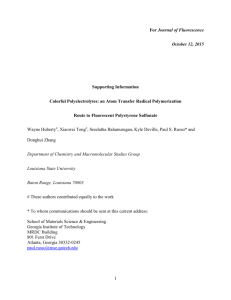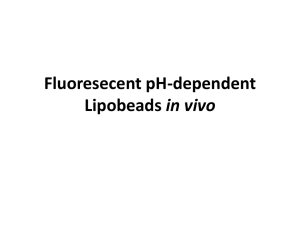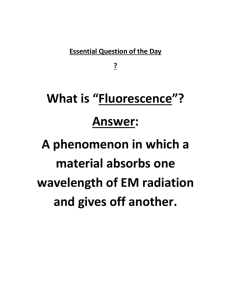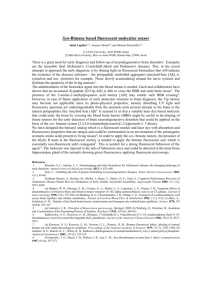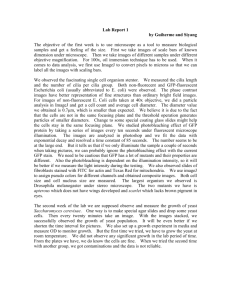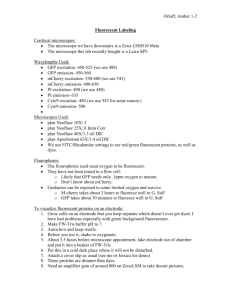What is Fluorescence
advertisement
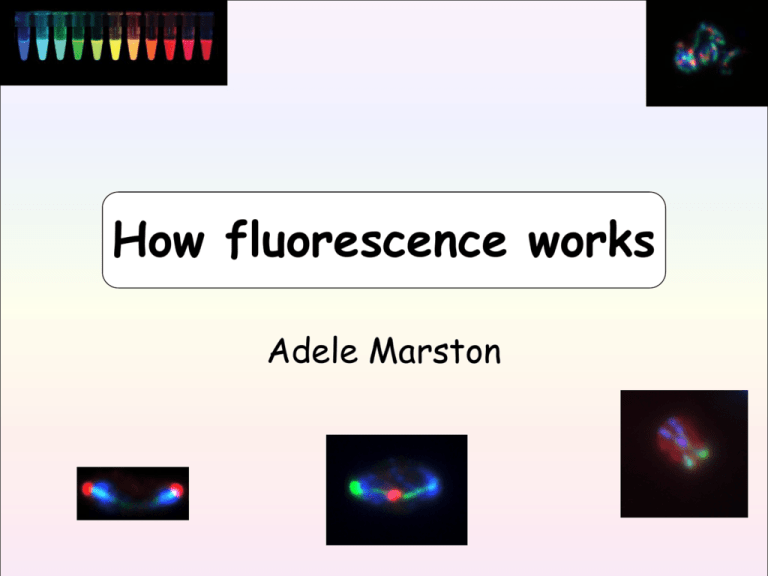
How fluorescence works Adele Marston Topics covered The nature of light and colour Colour detection in the human eye The physical basis of fluorescence Fluorescent probes and dyes Dyes that bind organelles Chemical Dyes Fluorescent proteins Photobleaching and Quenching The Nature of Light Light is a form of electromagnetic radiation The energy of light is contained in discrete units or quanta known as photons Photons have the property of both particles and waves Light as a wave: For simplicity, usually only the electrical component is drawn The nature of light and colour - 1 The Electromagnetic Spectrum Wavelengths 400nm-750nm are visible to the human eye The nature of light and colour - 2 The Human Eye Can detect differences in light intensity and wavelength (colour) Sensitivity Peak sensitivity is at 555nm (yellow-green) In bright light, 3 orders of magnitude After time to accommodate, 10 orders of magnitude! Resolution ~0.1mm for an object 25mm from the eye Composed of Rod and Cone cells Colour detection in the human eye - 1 Rod cell photoreceptors comprise 95% of photoreceptors in the retina active in dim light but provide no colour sense peak sensitivity at 510nm (blue-green) contain Rhodopsin Retinal Bright light temporarily bleaches Rhodopsin (20-30 min recovery time) Best high visual sensitivity in a darkened room Colour detection in the human eye - 2 Cone cell photoreceptors comprise only ~5% of photoreceptors in the retina contained nearly exclusively in fovea (0.5mm spot) 3 types: red, green and blue Action spectra differ for the different cone cells Colour detection in the human eye - 3 Positive and negative colours Positive colours are generated by combining different colour wavelengths --> Yellow perceived by stimulating red and green cones individually with 2 different wavelengths Negative colours are generated by the subtraction (absorption) of light of a specific wavelength from light composed of a mixture of wavelengths --> Yellow perceived because a single wavelength stimulates both red and green cones Colour detection in the human eye - 4 Fluorescence Occurs following excitation of a fluorescent molecule upon absorption of a photon Energy is released as light as the molecule decays to its ground state excited states excitation energy loss (rapid 10-9-10-12s) emitted light (longer wavelength) Emission absorption ground state Jablonski diagram Typical fluorochrome: 100,000 cycles per second for 0.1-1 seconds Fluorochrome “a molecule that is capable of fluorescing” The physical basis of fluorescence - 1 Excitation and Emission Spectra Filter set For FITC (fluorescein-5isothiocyanate) coupled to IgG To detector (eyepiece/ camera) Light in Stoke’s shift to objective FITC filter set (Chroma) excitation dichromatic mirror emission wavelength The physical basis of fluorescence - 2 Emission intensity depends on the excitation wavelength The physical basis of fluorescence - 3 Properties of fluorophores Stokes shift - difference between excitation and emission maxima (large advantageous) Molar extinction coefficient - potential of a fluorophore to absorb photons Quantum efficiency (QE) of fluorescence emission fraction of absorbed photons that are re-emitted Quantum yield - how many photons emitted by a fluorophore before it is irreversibly damaged Quenching - quantum yield (but not emission spectrum) altered by interactions with other molecules Photobleaching - permanent loss of fluorescence by photon-induced chemical damage Fluorescent probes and dyes - 1 Choice of Fluorophore will depend on the application Some applications of fluorescence microscopy Protein localization (Immunofluorescence microscopy or GFP-tagging). organelle marking (e.g. DAPI to label nucleus) protein dynamics (FRAP ) protein interactions (FRET) ion concentration (using ratiometric dyes) enzyme reactions (“caged” fluorescent compounds) cell viability (viability-dependent permeabilization) Fluorescent probes and dyes - 2 Fluorochromes in microscopy Biologically active fluorescent compounds - bind directly to cellular structures Chemical dyes - most need to be coupled to a macromolecule to be useful in microscopy Fluorescent proteins - can be fused genetically to a protein of interest Fluorescent probes and dyes - 3 Dyes that bind cellular structures or organelles FM4-64 and DAPI DAPI Sporulating Bacillus subtilis Crystal structure of DAPI bound to DNA Dyes that bind organelles - 1 Chemical conjugation of fluorescent dyes to chemicals that bind cellular structures Rhodamine-coupled Phalloidin (Phalloidin is a mushroom toxin that binds to F-actin) Dyes that bind organelles -2 Immunofluorescence microscopy fluorophore Secondary antibody Primary antibody anti-mouse mouse Use antibodies raised against your protein of interest OR… anti-rabbit rabbit Chemical Dyes -1 Epitope tags in Fluorescence microscopy Fuse protein of interest to an epitope “tag” Gene X 6xHA Common epitopes = Myc, HA Buy commercially-available antibodies to the epitope and use as primary antibody for IF Advantage: Fast (do not need to raise antibodies) Disadvantages: Protein fusion may not be fully functional Problems of specificity of antibodies to tag Chemical Dyes - 2 Fluorophores for microscopy Fluorescein and Rhodamine derivatives Fluorescein (IgG-coupled) (FITC) Texas Red (IgG-coupled) Tetramethylrhodamine (dextran coupled) (TRITC) 520nm - green 601 nm - red 573 nm - red Coupled with Isothiocyanates - allows attachment via amino groups in proteins Chemical Dyes -3 Improved dyes (brighter, more stable) CyDyes (Cyanine dye-based) Amersham-Pharmacia Inc Alexafluor (molecular probes/ invitrogen) Chemical Dyes -4 Qdot nanocrystals Extremely photostable Small semi-conductors cadmium/selenium Zinc sulphide Different wavelengths achieved by varying size of crystal (molecular probes/ invitrogen) Chemical Dyes -5 Multicolour labeling can simultaneously image multiple fluorophores e.g to localize multiple proteins in the same cell need to isolate the signal from each fluorophore individually 1) Choose fluorophores with minimum emission overlap 2) Choose filter sets that minimize “bleed through” into another channel suitable not suitable Chemical Dyes -6 Fluorescent proteins Green Fluorescent protein (GFP) isolated from the jellyfish Aequorea victoria Short flexible linker GFP My protein Fusion protein Advantages: can use in live cells fixing artefacts avoided dynamics Disadvantages: photobleaching folding environment dependent functionality of fusion protein Other fluorescent proteins from other organisms e.g. DsRed from Discosoma (26% homology with GFP) Mutagenisation of GFP --> more stable --> spectrally shifted variants Fluorescent proteins -1 GFP variants GFP (wt) 395/475 509 Green Fluorescent Proteins Yellow Fluorescent Proteins EGFP 484 507 EYFP 514 527 Kusabira Orange 548 AcGFP 480 505 Topaz 514 527 mOrange 548 562 TurboGFP 482 502 Venus 515 528 dTomato 554 581 Emerald 487 509 mCitrine 516 529 dTomato-Tandem 554 Azami Green 492 505 YPet 517 530 DsRed 558 583 ZsGreen 493 Blue Fluorescent Proteins 505 PhiYFP 525 537 DsRed2 563 582 ZsYellow1 529 539 DsRed-Express (T1) 555 EBFP 383 445 mBanana 540 553 DsRed-Monomer 556 Sapphire 399 511 mTangerine 568 585 T-Sapphire 399 Cyan Fluorescent Proteins 511 mStrawberry 574 596 ECFP 439 476 AsRed2 576 592 mCFP 433 475 mRFP1 584 607 Cerulean 433 475 JRed 584 610 CyPet 435 477 mCherry 587 610 AmCyan1 458 489 HcRed1 588 618 mRaspberry 598 625 Midori-Ishi Cyan 472 mTFP1 (Teal) 462 492 Shaner NC, Steinbach PA, Tsien RY (2005) A guide fluorescent proteins. Nat Methods. 2(12):905-9. Orange and Red Fluorescent Proteins HcRed-Tandem 590 mPlum 649 590 to choosing Fluorescent proteins -2 Photobleaching Photobleaching: a fluorophore permanently loses the ability to fluoresce due to photon-induced chemical damage and covalent modification. Largely due to the generation of free oxygen radicals that attack and permanently destroy the light-emitting properties of the fluorochrome. *Triplet state - VERY REACTIVE may interact with another molecule to produce irreversible covalent modifications (photobleaching) excited state Fluorescence (10-9 - 10-12 sec) (nSec-pSec) Absorption (10-15 sec) ground state *Triplet state Internal conversion (heat) Phosphorescence (102 - 10-2 sec) (100Sec-0.01Sec) Photobleaching and Quenching - 1 How to reduce photobleaching Photobleaching influenced by: chemical reactivity of the fluorophore intensity and wavelength of the excitation light intracellular chemical environment Reduce photobleaching by: choice of fluorophore limit exposure time (but will reduce emission) use of antifade reagents Photobleaching and Quenching - 2 Antifade Reagents Act by scavenging reaction oxygen species Common Antifade Reagents DIY (buy from Sigma) p-phenylenediamine n-propyl gallate DABCO Propriety SlowFade ProLong Antifade kit Vectashield Molecular Probes (Invitrogen) Molecular Probes (Invitrogen) Vector laboratories Photobleaching and Quenching - 3 FRAP (Fluoresence recovery after photobleaching) phenomenon of photobleaching is exploited in FRAP FRAP- learn how dynamic a protein is by monitoring recovery of fluoresence after photobleaching bleach Time taken to recover Photobleaching and Quenching - 4 Quenching Quenching - reduced fluoresence intensity as a result of the presence of oxidizing agents or the presence of salts of heavy metals or halogen compounds Quenching reduces emission Quenching sometimes results from the transfer of energy to other “acceptor molecules” close to the excited fluorophore = Resonance energy transfer Resonance energy transfer has been exploited to measure the proximity of two molecules in a technique called FRET (Fluoresence energy transfer) Photobleaching and Quenching - 5 FRET (Fluoresence resonance energy transfer) FRET is a distance-dependent interaction between the electronic excited states of two dye molecules in which excitation is transferred from a donor molecule to an acceptor molecule without emission of a photon Donor and acceptor molecules must be in close proximity (10-100Å) Fluoresence at emission wavelength of acceptor indicates that FRET has occurred (donor and acceptor are close) Photobleaching and Quenching - 6 Background information and suppliers on the web Molecular probes (invitrogen) (good background and products) probes.invitrogen.com/handbook/ Amersham Biosciences (CyDyes) www.amershambiosciences.com/ Jackson Immunochemicals (secondary antibodies) www.stratech.co.uk Clontech (GFP vectors) www.clontech.com Vector laboratories (antifade) www.vectorlabs.com Olympus (excellent general info and tutorials) www.olympusmicro.com Chroma (filter sets) Book www.chroma.com Fundamentals of light microscope Molecular Expressions (general info) and electronic imaging www.microscopy.fsu.edu/ Douglas B. Murphy. Wiley-Liss Nikon (general info - good for GFP) 2001 ISBN 0-471-25391-X http://www.microscopyu.com
